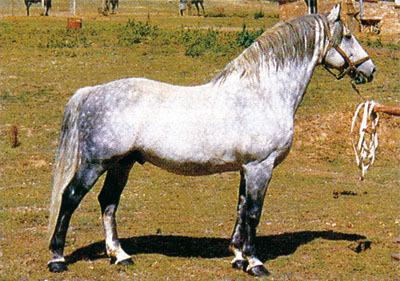
Flaneur as the first imported licensed and performance tested stallion, bred a huge number of mares, but produced very few competitors. The eventing mare, Holiday, was competitive at Advanced level, a stallion son, Condor, competed Prix St Georges dressage, while the showjumper, Gran Boneur competed in several World Cup qualifiers without placing.
The Flaneur son, Christofle (out of a Thoroughbred mare) won numerous led and ridden stallion classes before he was gelded, but not before he sired the Atlanta and Sydney eventing gold medallist, Darien Powers. Another eventing grandson, Rimini Park Fabian (by Pfrinzen) went clear cross-country, twice, at the world’s toughest three-day event, Badminton.
It was a modest return, and perhaps emphasised the folly of trying to breed opposites to get the perfect amalgam, as in, our horses are a bit too light and lack power, let’s find the biggest ‘tank’ we can and the result will be perfect…

As a broodmare sire, Flaneur, teamed with the blood of another import from Holstein, Contact (by Cor de la Bryère out of Section by Grant II, imported in 1976) produced the international dressage horse Northern Charisma, who competed at the World Cup Dressage final in Dortmund in 1999. Charisma was bred at Jan and Peter Powles’ Northern Warmblood Stud, and although this stud did not set out to breed Holsteiner horses, it used mainly Holstein bloodlines. At one stage they had 18 Flaneur daughters – but after considering the results, kept only three as ongoing members of their breeding program.
Peter Powles’ first foal arrived in 1969, just a week before he married his wife, Jan. The foal – Fleur – proved a winner, and was the dam of the 1987 Royal Melbourne Show Champion Warmblood stallion, Northern Campaign.
Peter soon refined his views: “Flaneur and the early horses were the big ‘old type’ farm horses. We had to change what we were breeding just like the Germans who were changing at the same time. I quickly realised that the heavy horse wouldn’t suit Australian riders and went for the lighter type, with a better power to weight ratio.”
The sire of Charisma was Northern Congress, by Contact out of a mare by Flaneur, out of a Thoroughbred mare by True Mist. Charisma was out of Northern Amblett by the Dutch import Arnhem (by the Thoroughbred, Abgar) out of a Flaneur / Thoroughbred mare.
Contact was the sire of Carlbrook Talkind, who was a member of the Australian showjumping team at the first WEG in Stockholm, as well as the world cup showjumpers Close Encounters and Schleswig Cognac (a member of an Australian showjumping team to New Zealand) and the advanced eventer, Carlbrook Contrast. He was also the sire of FEI dressage horse, Corroboree.
According to Peter Powles, Don Paul who had imported Flaneur, went back to Germany looking for another stallion.
“Don arrives at the Holsteiner Verband and there is an old guy sitting on a hay bale, throwing stones at the youngsters who are free jumping in the arena. He tells him that the best colt they had bred in years had been sent to Australia some time previously, mainly because he was by this controversial French stallion, Cor de la Bryère. He tells Don that the horse that went to Australia had one of the best jumping styles he’d seen, and that lots of that first crop of foals were beginning to prove themselves. Australia, the old man said, was very lucky and they probably didn’t know what a gold mine they had.”
“So Don Paul returned to Australia, hoping to buy that son of Cor de la Bryère – Contact. Don died soon after he returned but I started looking for sons of Contact. I bought Northern Ty Cardin, out of an Anglo-Arab mare, and then bred Northern Congress out of a Flaneur mare. And now we are thrilled to say that the old fella – Contact, himself – is coming down to stand at our stud in June or July of this year” (this was in1988).
Contact had been imported by Linda Mayer, who was 20 years old at the time, and she soon found herself the target of a vicious smear campaign, with rival stallion owners muttering about ‘the French disease’ and drawing attention to a trotter in Cor de la Bryère’s pedigree – the trotter was born in 1924 and appeared four generations back!!! I guess there are not many questions about Cor de la Bryère’s bloodlines nowadays…
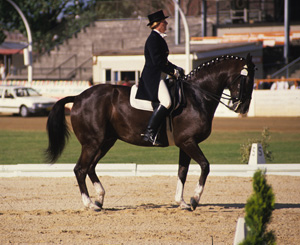
Although originally registered with the AWHA, Contact was later de-registered in the mid-80’s, but then re-registered later again after he was purchased by committee members of the AWHA’s ACT branch. Even the Holsteiner Association which had initially refused to register Contact, eventually fell into line, especially after Holsteiner stalwart, Norm Raphael purchased the Contact son, Melody Contact.
Northern Charisma was ridden by Rachael Downs (now Sanna) who also competed on Northern Aphrodite at the Sydney Olympic Games. Like Charisma, Aphrodite was out of a mare of Flaneur breeding – Northern Catherine II by Northern Congress out of a Flaneur / Thoroughbred mare. Aphrodite was by another of the Northern stallions, Falkland Victory – representing yet another vein of Holsteiner breeding that grew up in the northern part of Australia – Queensland – and yet again, the breeder was a German migrant, this time Gerhard Quast originally from the town of Lander near Elmshorn.
Gerhard arrived in Australia in 1956 and soon established himself as a strawberry farmer, but he saw the market for Warmblood horses, and so imported his first stallion, Monopol in 1975. Monopol was born in 1972, by Moltke out of a mare by Aldato.
In Germany, Gerhard had seen the successful use of trotter (Standardbred) mares to breed jumping horses, and followed suit in Australia (besides, Standardbred mares were even cheaper to buy than slow Thoroughbreds). So Gerhard bred Monopol over his trotters and established a dynasty.
Gerhard imported another stallion, Falkland (Farnese / Lopshorn) in 1979, yet another, Lander (Lorenz / Fasolt) in 1983, and then Cassanova ( Coriander / Lord Calando ) in 1998. None of Gerhard’s imports were licensed or performance tested in Germany.
Falkland Victory is by Falkland out of Moneyella (by Monopol). Another successful stallion from the Quast farm was Falkrich, again by Falkland out of a half trotter mare by Monopol.
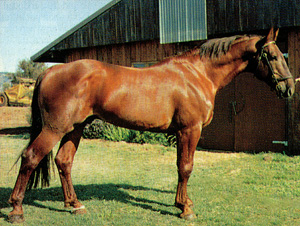
Despite only covering a handful of mares each year throughout his career, Falkrich was one of the more successful sires in Australia. His stallion son, Wirragulla Nicklaus (out of a mare of Trakehner / Hanoverian breeding) won a number of World Cup Showjumping qualifiers and was a candidate for the Australian showjumping team at the Beijing Olympics. Falkrich also produced two Grand Prix dressage horses, Finagin and Frontier and several better than useful eventers.
As is common in Australia, Gerhard also established his own studbook – the Holsteiner Breeders Association of Queensland in 1978.
In 1976, another Holsteiner stallion was imported to Australia, this time Romedio (by the Ramzes’ son, Rigoletto). Romedio was the sire of the FEI dressage horse, Snowview Romboli (out of a Flaneur / Thoroughbred mare) bred by Norm Raphael.
Norm started breeding Holsteiners at the beginning of the 1970’s and he was one of the founders of the Holstein Horse Association of Australia. Not surprisingly, Norm’s first stallion was a Flaneur son, Flaxon, out of a Thoroughbred mare. Since then he has sent mares to almost all the Holsteiner stallions that have come to Australia: Romedio, Wildfeuer, Talisman, Rocadero.
Because of the difficulty of obtaining frozen Holstein semen out of Germany, Norm turned to the United States, using the semen of Riverman (by the Rebel Z son, Redfort).
Norm stood two sons of Riverman: Snowview Revelation, out of a mare by his original stallion, Flaxon, and Snowview Mount Royal, out of a mare by the Romedio son, Mountbatten out of a Flaneur mare.
Norm was a passionate believer in the Holstein horse:
“I’ll only breed Holsteiner to Holsteiner, otherwise you are just mongrelising. It’s the same if you want to breed a German Shepherd, you don’t cross with a Labrador! The Holsteiner is a breed all of its own.”
Another FEI dressage horse was Isle of Hinton, bred by another of the ‘founding fathers’ of the Holsteiner breed, David Quick of Isle of Wight Farm. A president of the Holsteiner Association, David stood a number of Holstein stallions. The first was the sire of Isle of Hinton, Grand Flaneur, by Flaneur out of a Thoroughbred mare, Lady Tudor.
Grand Flaneur, like the next stallion David stood, Grand Isle, was bred by another of the founding members of the Holsteiner Association, Anne Duncan, and his pedigree is a summary of the early history of Holsteiner breeding, particularly in the southern state of Victoria. He is by Grand Flaneur, and out of Vagabond Gardenia, by Romedio out of a mare by the Flaneur son, Boss Cockie.
Isle of Wight produced another FEI dressage horse, HRH (by Melody Contact II, by Contact, out of a Flaneur mare).
The formation of the Holsteiner Association was in part inspired by dramatic news from the West of Australia. In 1974 and 1975 André van Helvoort imported two Holsteiner stallions and nine mares (two of which were in foal and subsequently produced fillies) to found his Barrabadeen Stud.
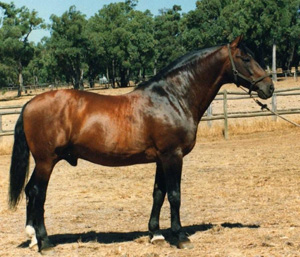
Van Helvoort’s foundation stock were well bred – he imported mares by Lord, Cor de la Bryère, Moltke I, Marlon xx, Farnese, Laertes, Wahnfried and Calypso I. The two stallions were Talisman (Tumbled xx / Marder) and Wildfeuer (Waterman / Ganeff). Wildfeuer was the Holsteiner licensing champion of his year. Talisman was ranked third in his selection year. Of the mares imported, Lafette, was a full sister to World Dressage Champion, Granat, Emillie, a full sister to Constant, and Koralle, sired by Lord. The first consignment of horses was more of the ‘traditional’ type of Holsteiner, with Wildfeuer and four mares. The second consignment was the start of the more ‘modern’ Holsteiner, with the arrival of Talisman and five mares.
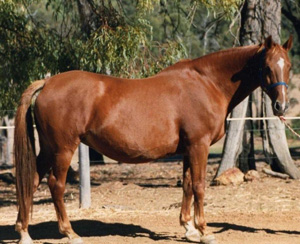
Western Australia suffers a little from being several days and a couple of thousand kilometers drive from the centre of equestrian activities on the East Coast, and the Barrabadeen stock had less opportunities to prove themselves. This was perhaps compounded by Mr van Helvoort’s personality – he couldn’t understand why Australians weren’t prepared to pay European prices for his European horses, especially at a time when Australians wanted to buy Warmbloods for dressage and he was offering jumpers…. Legend has it that when he died in 1986 there were large numbers of unbroken horses of mature age roaming the paddocks.
After taking over the reins from his father, Robert van Helvoort placed horses with talented riders, ensuring that they had their chance in competition.
However Barrabadeen did produce World Cup showjumpers: Tycoon, Warrigal, Maximus and Ularoo, and the Advanced showjumpers, White Dimple, Hattrick, Rembrandt, Wildfang, Super Nova (ex Triumph), Trinity and Wild Flame. In dressage, the Barrabadeen prefix was carried by an Australian Grand Prix champion, Troubadour (albeit in a year when our top horses were competing in Europe) while Fortune was exported to the USA where he competed in Grand Prix dressage and showjumping. Barrabadeen Bundaberg had the rare distinction of being exported to Germany by Harry Boldt. At its height Barrabadeen Holsteiner Stud was one the largest Holsteiner horse studs in the world with some 100 Holsteiner horses.
If the establishment of Barrabadeen had been the most exciting development of the 70’s for the Holsteiner breed in Australia, the highlight of the 80’s was the establishment by Perth couple, Tony Trevisan and Robynne McTaggart, of yet another Western Australian breeding farm – Noblewood Stud, based on a star-studded group of mares and stallions imported in three waves.
The first, in 1991, saw the importation of three mares and a stallion. These mares were by Corrado, Landgraf and Lord and the stallion, Jadalco, was a licensed Belgian Warmblood Stallion by the Farnese-bred Fabio I. The stud also imported another Coriander mare in 1996, which was then sold and re-exported to Germany.
Then in 1997, the stud acquired eight mares and another stallion. The eight mares were either proven performance mares or State Premium mares – including three full sisters to standing German stallions one of which was the famous Calvaro Z. The mares were by sires such as Cantus, Burggraaf, Coriander, Loutano, Voltaire, Ramiro Z, Caletto II, Calando I. The stallion Collins (exported back to Germany in 2003) was by Calando I. He was selected as Reserve for the Australian team qualifying Australia for the 2004 Olympic Games.
2004 saw the arrival of three mares by Quidam de Revel, Cassini II and Carpaccio (Caretino). 2007 brought two more mares by Capo (Calando I) and the new licensed stallion purchased from the Holstein Verband auction in November 2006, Casino Royale (Casall / Levantos I). These two mares, their foals (by Cassini II) and the new stallion arrived in Australia in September 2007.
Currently the Stud has a showjumping team of five: three horses in Eastern Australia – Primadonna (Carpaccio / Calypso II) who is being campaigned by Jamie Coman who rode for Australia at the Sydney Games, and who was until recently Australian National Showjumping coach, and two with Vicki Roycroft – Cassini’s Girl (by Cassini II) and Blatini (Burggraaf / Cantus) who has been the leading showjumping mare in Australia in 2005 and 2006 and a winner of eight World Cup qualifiers. In the West, Rick Dabner campaigns Cougar (Calando I / Lord), Leilani (Liostro / Voltaire) and will also campaign the new stallion Casino Royale.
The stud stood four stallions: Cougar, by Collins (Calando I / Caletto II) out of a Coriander mare from the famous stamm 776; Ice by Indoctro out of the full-sister to Calvaro Z; Beretta (a full brother to the jumping team member, Blatini – by Burggraaf out of a Cantus mare) and the most recent import, Casino Royale (Casall / Levantos I / Lombard).
Since this was written the couple split, and the stud was greatly reduced in size – a notice on the website records the closure of Noblewood –
“Recently, Robynne decided to wind down the breeding and in March 2020, one of the last, if not the last, Noblewood foal was born at the farm and what a great foal to finish on – Noblewood Park Chaos – by Noblewood Park Cougar out of Noblewood Park Leisha by the German stallion Liostro out of our imported mare Lidwina which was by Ramiro Z. As a breeding barn we are passing the Noblewood brand onto Gemma Alexander Gonzalez @gemmalaurel who has in her care a number of Noblewood mares which she will continue to breed with the Noblewood brand along with her own brand Contarli Performance Horses.”
Next month – The Australian showjumping riders discover the Warmblood…History

